Island Stories:
![]() Danzig
Mine
Danzig
Mine
![]() Zeballos
Iron Mine
Zeballos
Iron Mine
![]() Conuma
Peak 1910
Conuma
Peak 1910
Alexandra Peak
Argus Mountain
Bate/Alava Sanctuary
Beaufort Range
Big Interior Mtn
Big Interior Mtn 1913
Part 1
Part 2
Bolton Expedition 1896
Cliffe Glacier
Clinton Wood
Comox Glacier
Comox Glacier 1922
Comox Glacier 1925
Comstock Mtn
Conuma Peak
Copper King Mine
Crown Mtn
Elkhorn 1912
Elkhorn 1949
Elkhorn 1968
Eugene Croteau
Golden Bullets
Golden Hinde 1913/14
Golden Hinde 1937
Golden Hinde 1983
Harry Winstone Tragedy
Jack Mitchell
Jim Mitchell Tragedy
John Buttle
Judges Route
Koksilah's Silver Mine
Landslide Lake
Mackenzie Range
Malaspina Peak
Mariner Mtn
Marjories Load
Matchlee Mountain
Mount McQuillan
Mt. Albert Edward
Mt. Albert Edward 1927
Mt. Albert Edward 1938
Mt. Becher
Mt. Benson 1913
Mt. Benson
Mt. Doogie Dowler
Mt. Colonel Foster
Mt. Hayes/Thistle Claim
Mt. Maxwell
Mt. Sicker
Mt. Tzouhalem
Mt. Whymper
Muqin/Brooks Peninsula
Nine Peaks
Queneesh
Ralph Rosseau 1947
Rosseau Chalet
Ralph Rosseau Tragedy
Rambler Peak
Red Pillar
Rex Gibson Tragedy
Sid's Cabin
Steamboat Mtn
Strathcona Park 1980's
The Misthorns
The Unwild Side
Victoria Peak
Waterloo Mountain 1865
Wheaton Hut/Marble Meadows
William DeVoe
Woss Lake
You Creek Mine
Zeballos Peak
Other Stories:
Sierra
de los Tuxtlas
Antarctica
Cerro del Tepozteco
Citlaltepetl
Huascaran
Mt. Roraima
Nevada Alpamayo
Nevada del Tolima
Nevado de Toluca
Pico Bolivar
Popocatepetl
Uluru/Ayers Rock
Volcan Purace
Volcan San Jose
Biographies
Island 6000
Cartoons
Order the Book
Contact Me
Links

The First
Winter Ascent of Elkhorn
March
23-24, 1968
by Alastair Watt
As this was a two-day trip, we had the luxury of a late start. We [Peter Busch and Alastair Watt] left Victoria on Saturday, March 23rd, at about 9 a.m. in Peter's bare-bones, stripped down Volkswagen Beetle. By "stripped-down" I mean it had no hood on the engine - "natural engine-cooling", as some wit described it. There was no snow on the road, and still none by the time we reached Campbell River. I commented that it might be a summer rather than a winter ascent, but Peter demurred: he had been up in the Strathcona Park area at this time of year before and knew what conditions would be like.
He was right. By the time we got to the Elk River, there was deep snow at the roadside. There was no trailhead in those days, so we just pulled off the road under some trees. I discovered that I had forgotten to buy film for my camera and so reluctantly left it in the Volkswagen. Just after we left, Peter pointed out that his car did not lock - another Buschian economy! - but as we were already on the trail, it was too late to do anything about it.
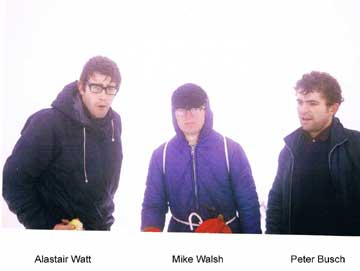 Initially,
the going was easy. The snow was a crust, with about two inches of powder
on top. Later, however, as we penetrated south up the Elk, the crust started
breaking and we found ourselves up to our calves and eventually our knees
in snow. We were carrying about 50 lbs each: ice-axes, a tent, spare clothes,
sleeping bags, food, cooking gear, some slings, carabineers and rock pegs,
a hammer and a couple of ice screws - we had no idea what we'd find up
there. I carried the rope and the hardware, Peter the tent. Our route
ran at first up the right, or west bank of the Elk. We could see Puzzle
Mountain and Kings Peak on our left. Eventually, Elkhorn itself hove into
view, displaying its distinctive Matterhorn-ish curved peak and rugged
North Face. I remember thinking that it was all quite intimidating and
that we would not get up it.
Initially,
the going was easy. The snow was a crust, with about two inches of powder
on top. Later, however, as we penetrated south up the Elk, the crust started
breaking and we found ourselves up to our calves and eventually our knees
in snow. We were carrying about 50 lbs each: ice-axes, a tent, spare clothes,
sleeping bags, food, cooking gear, some slings, carabineers and rock pegs,
a hammer and a couple of ice screws - we had no idea what we'd find up
there. I carried the rope and the hardware, Peter the tent. Our route
ran at first up the right, or west bank of the Elk. We could see Puzzle
Mountain and Kings Peak on our left. Eventually, Elkhorn itself hove into
view, displaying its distinctive Matterhorn-ish curved peak and rugged
North Face. I remember thinking that it was all quite intimidating and
that we would not get up it.
We crossed the Elk about three miles short of the peak. I think the river may have been frozen, for we had no difficulties and did not have to resort to fallen tree trunks or aerial traverses as summer parties do. On the other side, we proceeded along a series of benches by which we gradually gained height. Looking grimly foreboding, Colonel Foster loomed at the foot of the valley, to the south-west.
We'd been on the approach for about five hours, and though Peter was going well, we were both tired, especially me. As it was about 6 p.m. and dusk was creeping in, we decided to pitch camp within sight of Elkhorn and go for it the next day. Here befell a serious miscalculation. Peter's tent was not the most up to date; it was army-surplus, and while its floor was, as we thought, rubberized, it was not, as it turned out, waterproof. In our exhaustion, we assumed it was waterproof and that that would save us digging out a snow base for the tent; we just pitched it, cooked some soup on the primus, rolled out our sleeping bags and crashed.
Thus began the coldest and most uncomfortable night I have ever spent in the mountains-even worse that my involuntary bivouac and subsequent frostbite on Ben MacDhui in the Cairngorms. First, the heat of our bodies melted the snow under the tent, and the water penetrated the non-waterproof floor and soaked us. Then, as we were camped at about 3,000 feet, the temperature dropped to -10C to -15C, froze the melt, and in doing so froze us. From about 2 a.m. we were so cold that we could not sleep. There was no point in putting on more clothes because they were all soaked. So we chattered our way to dawn. Finally, at first light, we rose as a man, threw the cooking gear and the ice-solid sleeping bags in the tent, and took off. We had neither time nor inclination for breakfast: the only things on our minds were to get moving and warm up.
Our approach to Elkhorn was roughly from the north-west. A series of rising tiers or natural banquettes seemed to lead to the rock face. The only thing was you had to keep climbing to the left, from one to the next level, otherwise natural gravitation would lead you to the foot of the valley. The tiers were separated one from the other by steep slopes of about 30-40 feet, but fortunately for us there were occasional fault-lines in these walls in the form of gullies and chimneys which we utilized on two or three occasions to scramble from one level to the other. Thus by a combination of axe-work and knees-and-elbows, we were able to work a route towards the rock face, which by now had disaggregated itself into the summit ridge and, guarding it on the right, a massive and impressive-looking gendarme. The climbing was not technically hard, but rather muscular and strenuous, and by this time we had warmed up sufficiently to break into profuse sweat.
The landscape had taken on that stark, monochromatic hue that appears only in true Alpine winter wilderness. The trees and rock face were black against a bleak white snow-scape. The sky was leaden grey, and ominous flurries periodically obscured the gendarme. I was still worried that the ridge and gendarme would pose problems that we, in our undernourished and sleep-deprived states, would not be up to. By this time, because we were climbing above the dangerous West Face, we were roped, moving in prescribed Alpine fashion. Peter breasted the top of another small gulley, brought me up and waved me on. To my incredulous eyes, it looked as though the slope on which we now stood ran at a 30 degree incline right up to the gendarme. I pressed on for a rope length, then brought up Peter. We still had a 100 feet to go, and were perched precipitously right above the West Face. While he rested, moving with unctuous care, I approached the gendarme, peeked round it, and to my joy and relief, found no sting in the scorpion's tail: before me, the slope fell away to a magnificent Golden Hinde, some six miles away, and to the left, the summit ridge beckoned to the top of Elkhorn, some 200 feet away.
All mountaineers know the agony of apprehension that precedes a summiting, followed by the warm glow of triumph that succeeds it. We were no different. It was 10.30 a.m., the flurries had temporarily abated, and somehow it just felt warmer. Peter pottered around on the summit, taking shots of Colonel Foster, Rambler Peak, Golden Hinde and me, while I stood pensively looking at the panorama of peaks around us, knowing that this was one the greatest "one-offs" we would ever experience.
The sun came out momentarily, but we had to get down. Again negotiating the slopes above the West Face with care (axe-belays and punctilious roping down), we moved faster on the flat, and even in the interconnecting gullies which were so full of snow that we could not do ourselves any damage. Within an hour and a half we were back in camp. Tent down and packed, a quick handful of trail food and a candy bar each for sustenance, and then, driven by pure exhilaration, we were off helter-skelter down the Elk, to arrive some three hours later, exhausted and half-starving, at the trailhead.
And yes, fulfilling my premonition, person or persons unknown had riffled through the Volkswagen and taken my camera while we were away. So someone in the Gold River area is probably to this day still enjoying a very fine Kodak camera!
The next day, back in Victoria, I had one of those moments of cosmic incongruity. Outside, when I rose, the sun was out, crocuses were pushing into bloom, and the whole of the area I lived in (Fairfield) was covered in those beautiful pink cherry blossoms that flourish there in spring. Try as I might, I could not reconcile this scene with the blank whiteness and cold winter wastes of the Elkhorn that we had trod the day before. In fact, driving to work, every corner I turned I half-expected the winter landscape to re-assert itself, such was the impression it had made on me. Shades of the myth of Pluto and Persephone, in which the vitalistic life-force Persephone escapes annually from the wintry fastness of Pluto!
Postscript:
I wrote this article some 43 years after the fact, not having been aware
of any interest in this ascent. I returned shortly afterwards to the UK,
where I stayed for three years, and in doing so lost touch with Peter.
But let me say that this was Peter's climb: he wanted to do something
in winter in the Strathcona Park area, and short of Colonel Foster, which
had not even been climbed in the summer (Mike Walsh was to do this in
July, 1968, some three months later), Elkhorn seemed do-able. Peter it
was who broke trail and dragged me along behind him, who rose above the
privations of a terrible night, and who willed us on to the summit. He
was a bull of a man, possessed of an incredible energy which relented
only when we were safely back down. I owe him this ascent.
I have looked at the route description in the Strathcona Park Guide, and note that it bears very little resemblance to my version. That is neither here nor there. If Peter wrote it, it merely shows how his impressions of the climb differed from mine. If someone else wrote it, then they too encountered a different set of challenges. Experience is individual.
As to the grading of the climb, I see the Guide gives it a Grade 3. Technically, it was not a hard climb. The only place where I felt discomfort was when we were contouring the steep snow slope above the West Face, and that was because of exposure rather than severity. But as a major expedition, extending over two days and involving some 14 hours of actual climbing, I would agree it warrants a 3. It is a climb that requires high levels of stamina, determination, and inner resources, and is not an expedition to be undertaken lightly.
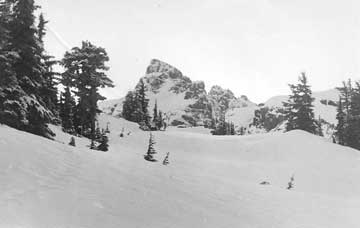 |
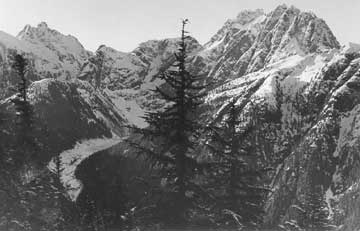 |
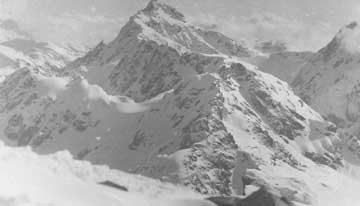 |
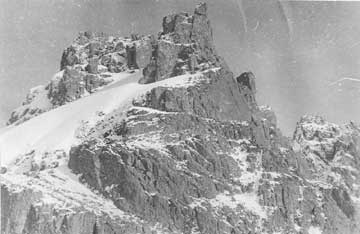 |
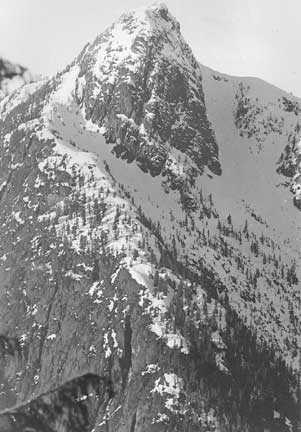 |
 |
How to order | | About the Author || Links || Home
Contact:
Copyright ©
Lindsay Elms 2001. All Rights Reserved.
URL: http://www.beyondnootka.com
http://www.lindsayelms.ca